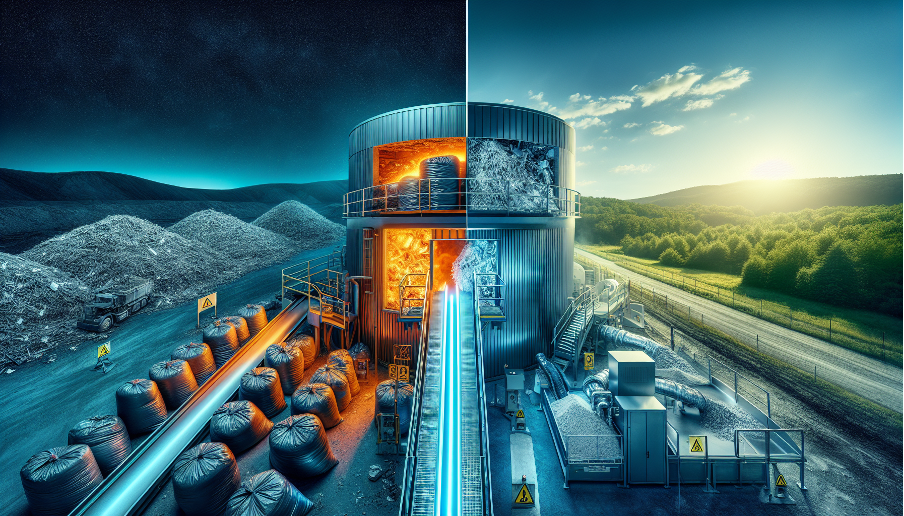Asbestos and the Circular Economy: Why It's Time to Stop Burying the Problem
Adam Fox • 9 April 2025
This is a subtitle for your new post

Asbestos and the Circular Economy: Why It's Time to Stop Burying the Problem
Twenty-five years after asbestos was banned in the UK, we’re still digging a hole—literally and metaphorically.
Every day, across the country, asbestos waste is double-bagged, labelled, loaded into skips, and driven to landfill, where it will sit indefinitely, taking up valuable space, creating ongoing liability, and adding to our already bloated environmental burden.
And yet, 2025 presents a different path. A smarter one. One that replaces disposal with repurposing, and turns a dangerous waste product into a useful, circular resource.
The technology exists. So the question we should be asking isn’t “Can we recycle asbestos?”
It’s “Why the hell aren’t we doing it already?”
Landfill is Failing Us—But We’re Still Relying On It
Let’s start with the basics. There are still over 1.5 million buildings in the UK that contain asbestos, most of them now approaching the end of their useful life. As these structures age or undergo refurbishment, the volume of asbestos waste is only going to increase.
Right now, we handle that waste the same way we did decades ago:
• Identify it
• Remove it (usually under fully controlled conditions)
• Seal it in heavy-duty plastic
• Drive it to landfill
• Bury it
• Forget about it
Except we don’t forget, do we?
Because landfill space is running out. Disposal costs are going up. And the environmental cost? We’re only just starting to count it.
There’s a Better Way—and It Already Works
Here’s what most duty holders don’t realise:
We no longer have to bury asbestos.
Thanks to recent advances in thermal treatment technology, we now have a method that can safely denature asbestos, breaking down its fibrous structure and rendering it harmless.
Companies like Thermal Recycling in the UK are already proving this is not science fiction. They’re using high temperatures to transform asbestos cement products—like corrugated roofing sheets—into an inert ceramic material that’s completely safe.
But here's the best bit:
That material isn’t just neutral. It’s useful.
It can be crushed and graded into aggregate, which can be used in road construction, paving, and concrete mixes.
Instead of creating a waste burden for the next generation, we’re creating a valuable, low-carbon building material.
Why Aggregate Matters in the Carbon Equation
The production of virgin aggregates—through mining and quarrying—is energy-intensive and environmentally damaging. It contributes significantly to CO₂ emissions and destroys natural landscapes.
So by replacing some of that demand with recycled aggregate from denatured asbestos, we:
• Cut carbon emissions
• Reduce dependence on extraction
• Shrink the environmental footprint of infrastructure projects
• Extend the life of quarries and reduce waste tonnage
That’s not just a win for waste management. That’s a win for the entire construction supply chain. And yet most people in the industry don’t even know it’s possible.
Why Are We Still Burying What Could Be Reused?
As someone who’s worked in asbestos compliance for over 20 years—and now helps business leaders manage risk more intelligently—I’ve seen the same patterns play out time and time again:
• “We’ll just do what we’ve always done.”
• “This project’s tight on budget—landfill’s cheaper, right?”
• “We’re just following the usual route—it’s less risky.”
Let’s be honest. That mindset is outdated, short-sighted, and lazy.
Cost may always be a factor, but the belief that landfill is “cheaper” needs to be challenged. Once you factor in:
• Long-term environmental costs
• Reputational risk
• Rising disposal fees
• And the public pressure for sustainable practices
Thermal recycling is already starting to make sense. Especially when the output is something usable, not something buried.
Licensed Contractors: You Don’t Get a Free Pass Either
This isn’t just about clients or duty holders. Licensed Asbestos Removal Contractors (LARC’s) have a moral obligation here too. And I say that not from a place of opinion—but from first-hand experience, day in and day out for over two decades.
Too often, LARCs put profits over progress.
They default to landfill because it’s faster, easier to price up, and keeps their margins clean. They know the alternatives exist—but they don’t explore them, let alone offer them to their clients.
When you hold a licence from the HSE, you’re not just a business—you’re a guardian of public health. That comes with responsibility. Choosing the most sustainable, forward-thinking disposal route should be part of that. Especially when the technology is available, proven, and legal.
It’s time for the industry to stop hiding behind what’s convenient and start leading from the front.
A Moral Obligation for Everyone Involved
Whether you’re a:
• Local authority managing public buildings
• Developer under pressure to go green
• Commercial landlord looking to reduce liability
• Or a licensed contractor with influence over disposal routes
—you have a responsibility to look beyond the cheapest or fastest option.
If there’s a proven, safe, and more sustainable way to manage asbestos, you have a duty to understand it before choosing to ignore it.
Because let’s be honest:
“We didn’t know” isn’t going to wash when the public starts asking why we’re still filling landfill sites with a problem we already have the technology to eliminate.
So What Can You Do Differently?
No one’s asking you to overhaul your entire waste strategy overnight. But you can—and should—start asking better questions:
• “Is landfill our only option here?”
• “Could this waste stream be recycled instead of buried?”
• “What suppliers, contractors, or experts do we know who can help us explore this?”
You don’t have to be a global pioneer.
But if you’re in a position of responsibility, you should at least be aware that the old way isn’t the only way anymore.
Final Thought: The Future Is Circular—Whether You Join In or Not
Asbestos will be with us for decades to come. That’s a fact.
But how we handle it—and whether we choose to keep repeating the past or do something smarter—is up to us.
Thermal recycling and other denaturing technologies offer a rare opportunity to do something that actually moves the industry forward.
Not just ticking the compliance box. Not just burying the problem. But solving it—and turning it into something useful in the process.
If you’re involved in asbestos management in even the slightest way, ask yourself this:
Are you part of the problem, or part of the solution?









